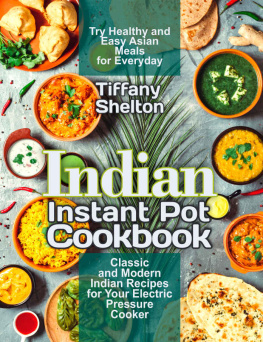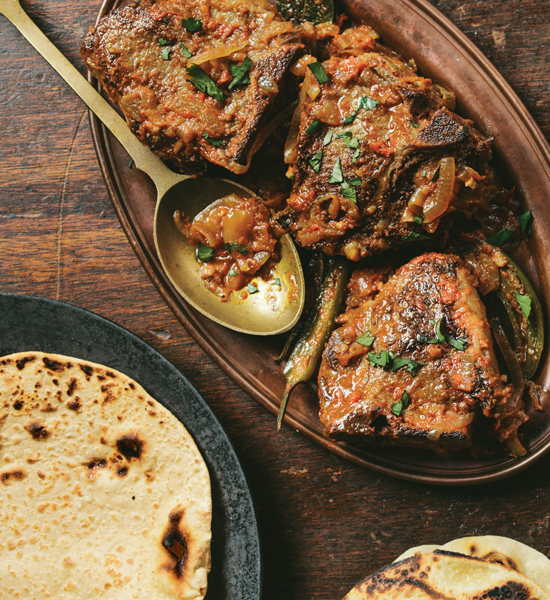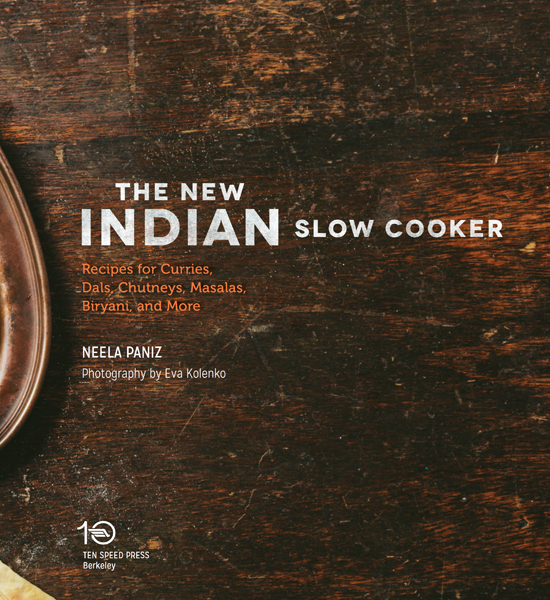Copyright 2014 by Fatehpur Enterprises Inc.
Photographs copyright 2014 by Eva Kolenko, except as noted below
All rights reserved.
Published in the United States by Ten Speed Press, an imprint of the Crown Publishing Group, a division of Random House LLC, a Penguin Random House Company, New York.
www.crownpublishing.com
www.tenspeed.com
Ten Speed Press and the Ten Speed Press colophon are registered trademarks of Random House LLC
All photos by Eva Kolenko with the exception of the cover and photos 2013 by Erin Kunkle
Library of Congress Cataloging-in-Publication Data
Paniz, Neela.
The new Indian slow cooker : recipes for curries, dals, chutneys, masalas, biryani, and more / Neela Paniz.
pages cm
ISBN 978-1-60774-619-5 (paperback) ISBN 978-1-60774-620-1 (ebook)
1. Electric cooking, Slow. 2. Cooking, Indic. I. Title.
TX827.P35 2014
641.5954dc23
2014014007
Trade Paperback ISBN: 978-1-60774-619-5
eBook ISBN: 978-1-60774-620-1
Jacket design by Katy Brown
Food styling by Lillian Kang
Prop styling by Ethel Bennan
Food styling by Robin Valarik
v3.1
TO MY JAAN!
Forty-four years and still going strong
contents
acknowledgments
I would like to start by thanking Aaron Wehner of Ten Speed Press, whose phone call started this process. Over fourteen years ago, Ten Speed Press published The Bombay Caf cookbook, and here they were offering me another book opportunity! But Indian food in a slow cooker: how was that going to work?
The journey has been enlightening and educational, and the support lent by my editor, Melissa Moore, has been invaluable; she has been there every step of the way. I spent the last few months of recipe testing and writing in India, and keeping in touch with Melissa via emails. Though we were oceans apart, it felt as if we were conversing across the table. Thank you.
To Lynn Alley, the author of The Gourmet Vegetarian Slow Cooker (part of a series of slow cooker books published by Ten Speed), for had I not read her book, I would still be pondering the decision to write this one. Thank you, Lynn; you have been a good friend, and a better teacher.
To Susan Pruett, whose recipe testing proved to be a great asset.
To my family in India, who watched me struggle at times with translating measures, ingredients, techniques, and other culinary matters from one culture to the other, for giving me the space I needed to write the book. I owe a big thank you to my younger sister, Radhika, an accomplished cook who opened her extremely well-staffed and well-stocked kitchen to me. She always found ways and means of meeting all my needs for testing the recipes. And thanks to her family, who readily sampled and critiqued the food that came out of this amazing machine.
To Gopi, Radhikas cook, dhanyawad! You interpreted the recipes through my instructions, and helped me prepare biryanis, soups, and a vegetable that I swore never to eatpumpkin. I have to admit, Gopi, that the kaddu ki sabzi was delicious!
And, forever, to my parents, Kiki and Mohinder, who together with our cook Chandan set the highest standards of food while I was growing up. They taught me everything there is to know about combining flavors, textures, and even colors on the dining table. They were also my biggest fans, and I miss them tremendously!
To my children, Nikhil and Payal, along with their spouses, and my grandchildren, who still think that their grandmother is the worlds best cooker, a very big thank you. You have been my biggest supporters and critics, allowing me to test my recipes on you throughout the years.
And finally, this book would never have been finished if it were not for Franklin, my dear husband. The time you have so diligently spent working alongside me during the cooking, eating, and writing has proven to be invaluable. Your writing skills and experience as a producer and editor for television news helped define the final manuscript. You have been my most ardent fan as I have been yours. After forty-four years, youve kept with me with laughter, tears, and sanity. I am forever thankful for all those moments, jaan ; lets keep writing together.
introduction
When I was asked if I would be interested in writing a book on Indian slow cooking, my immediate thought was that it was not possible to achieve in a slow cooker what one did in a saucepan. Indian food is based on slowly built combinations of spices and aromaticsyou patiently brown the onions, fry the spices, roast the vegetables, tending to the pot to keep all moving along without sticking or burning. The slow cooker would be a new route to a crucial destination: the vibrant, deeply satisfying flavors of traditional curries, dals, chutneys, and more. I didnt know if it could be done.
My memories of Chandan, the cook my mother employed for over forty years, helped me decide to take the challenge. Chandan treated us to the most amazing meals full of vibrant flavors. He would buy fresh produce and meats from the market every day, seeking out the best quality and value. You could hear him, busy in the kitchen, butchering or grinding the meat, cleaning the poultry and seafood, and prepping the vegetables. And then there would be the sound of the spices being ground in a stone grinder. The bottom slab of stone had been pounded with small depressions to create a rough surface; the top, smaller stone resembled a thin brick. Chandan would sit on his haunches and grind dry spices between the stones, or make a paste of spices with ginger, garlic, and chiles. In the mid-1970s, on one of my visits home to India, I bought my mother a food processor, and Chandan could not have been more delighted to have this modern method of grinding his spices. Of course, it would never be quite the same as the stone grinder, but it saved his back. As time went on, more modern conveniences made their way into my mothers kitchen. When Chandan retired and Prem Singh took over the duties of the kitchen, I rarely saw the old pathar (stone) come out of its hiding hole. He was a modern cook, using the food processor, spice grinder, juicer, blender, and pressure cooker. I wager he would have made great use of a slow cooker.















